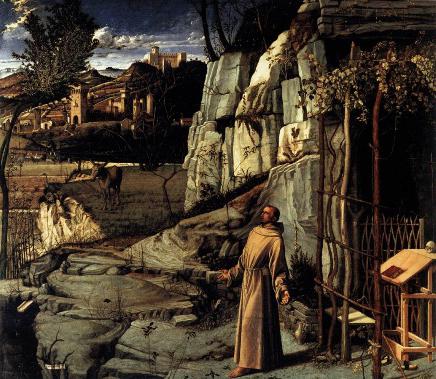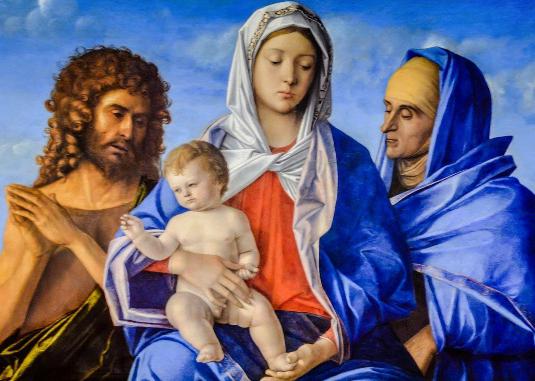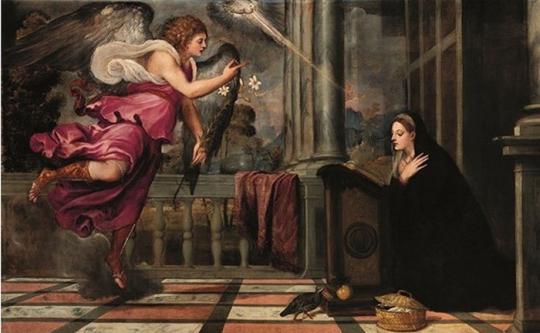Giovanni Bellini (1433 - 1516) - an outstanding painter of the Renaissance, the youngest son of Venetian painter Jacopo Bellini. The first mentor of Giovanni was his father, his older brother Gentile had some influence on the work of the novice draftsman.
Relationship with the master
The most significant role in the development of the young artist was played by the famous painter Andrea Mantegna, who entered the Bellini family in 1453, becoming the husband of Giovanni’s sister, Nicolozia.

Personal relationship between newly mintedrelatives quickly turned into a mutual professional interest in painting. Andrea, as the brightest representative of the Tuscan and Florentine school of painting, was able to pass on all his experiences to Giovanni. After Andrea became the court painter of the Duke Gonzaga in 1460, his lessons became periodic, but the influence of the master was still significant.
Themes
Pictures of Bellini Giovanni of the first period of hiscreativity are particularly focused plot themes. He chose "Madonna and Child". Subsequently, the artist will write many Madonnas in the Venetian style, all of them will be portrayed as thoughtful and deep in their thoughts. Almost all the paintings of Bellini Giovanni are marked with a stamp of in-depth self-contemplation of the characters. The best "Madonna", written in 1460, is considered to be the "Greek Madonna".

Canvas size 82h62 centimeters created withelements of iconic classics, Madonna reminds the Virgin Mary, but with more life expressiveness. The baby in her arms is depicted in a more material dimension.
Bellini Giovanni's paintings dedicated to Madonnaalthough they wore a shade of holiness, they were still quite earthly. The artist did not strive to give his characters the biblical spirit; this turned out unwittingly, since the theme of the images was rather closely intertwined with the canons of theology. Moreover, during the Middle Ages, religious beliefs dominated in all spheres of public life, and only those artists who followed church laws were in demand. All others were declared heretics.

Sacredness
In 1462, Giovanni set about creating fourlarge triptychs for the church in Venice, which were installed on the family altarpieces scuola. The paintings of Bellini Giovanni had already lost the image stiffness inherent to beginning artists, the composition became softer, smoother. And although his main mentor, Andrea Montenya, preached precisely the rigidity of the drawing, Giovanni moved away from this postulate. He developed his own style of writing.
Dutch methods
In the period from 1470 to 1480.Bellini was influenced by the famous portrait painter Antonello da Messina, famous for his technique of using the pure oil painting method. This style Yes Messina took over from the Netherlands artists. He denied tempera, preferring oil paints, which, in his opinion, are able to convey the depth of saturation in full.
Bellini Giovanni, whose paintings have already containedcolored shadows, became a follower of the teachings of Antonello. The paintings "Lamentation of Christ" (1480) and "Madonna with Saints" (1476) are an example of tragic grandeur, reflected in the manner of oil painting. In the art of Bellini of that time there is a transition from the early Renaissance to the era of the High Renaissance.

"Madonna with Saints"
The painting was painted for the church of San Jobbe inVenice and was the altar Sacra Conversazione. Elements of iconography are visible in the image, the Madonna is raised on a throne in front of the church apse, the saints around her are in a state of brooding contemplation. The location of the characters is deeply thought out, the interrelation of the saints is evident. Madonna is out of space given to others - she has her own level.
Church image of the painting Bellini Giovanni "Madonnawith the saints "is distinguished by an equilibrium composition, enlightened by the spirituality of characters immersed in thought. The artist tries to combine the sacredness of the plot with colorful outfits, and he succeeds in it to the full - the content of the canvas is organic and obeys the author's idea.
"Lake Madonna"
At the turn of the fifteenth and sixteenth centuriesBellini Giovanni, whose paintings have already been considered an example of high art, created one of his most significant works. It was the "Lake Madonna", which produced the impression of an elusive juxtaposition of life and death. Hence the inescapable religiousness of the canvas, the depth of peace and cleanliness. "Sacred Allegory" (another name for the picture) gathered on the Venetian terrace the main characters of the sacral sense, which are interconnected in the context of the artist's attitude to the world. This is the Mother of God towering on the marble throne; women; old men; Sebastian, pierced by arrows; babies on the mosaic floor. Behind the railing are the apostles Paul and Peter.

Bellini Giovanni, "Madonna and Child"
One of the most famous paintings of the artist inCurrently located in the largest museum in the world - the Metropolitan (in New York). Canvas size 89h71 centimeters represents the Renaissance. The picture is comparable in popularity only with the "Jock" Leonardo da Vinci, which is located in the Louvre in Paris.
"Crucifixion"
On the canvas, created in 1503, the artistdepicted the executed Jesus Christ. The picture is dominated by a rigorous perspective, moving into an expanded space. The organic interaction of volumes softens the tension of the plot. In the painting by Bellini Giovanni "The Crucifixion", one can trace the pictorial techniques of "Chichacento", to which the artist will turn more than once in his further work.
Crucifixion of Christ reflected on the background of paraphernaliaIslam, in the distance visible minarets and buildings in the Oriental style. The cross is dug among the abandoned cemetery monuments, on the ground below are human skulls. The overall situation is depressing, around - not a soul. Jesus crucified on the cross is emphatically lonely.
Painting as a cultural heritage
Pictures of Bellini Giovanni with a description of the plot,indicating the period of creation and other data are in the largest museums of the world. All of them are part of world cultural heritage and belong to all mankind. Even those paintings owned by private collectors are indirectly included in the UNESCO lists as an integral part of world culture.

Special publishers produce museumcatalogs representing the work of Giovanni Bellini - paintings (with names, date of origin, chronology and storage conditions). The books also contain biographical information about the painter, the story of his life and death.

Masterpieces
During his long life the artist wrote thirty-nine works, many of which are included in the collections of world-famous museums.
These are the paintings created by Bellini Giovanni. The list is impressive:
- "Dead Christ Supported by Angels", 1460, Venice, Correr Museum.
- "Madonna and Child", 1455, is located in the museum of the city of Pavia.
- "St. Jerome Preaches the Lion", 1450, Birmingham, Barber Institute.
- "Greek Madonna", 1460, Brera Gallery, Milan.
- Prayer of the Bowl, 1455, London, National Gallery.
- Pieta, 1455, Bergamo, Carrara Academy.
- "Bringing to the Temple", 1460, Venice, Gallery Querini Stampaglia.
- The Transfiguration, 1455, Venice, Correr Museum.
- "Pieta", 1458, Milan, Brera Gallery.
- Triptych of St. Sebastian, 1464, Venice, Gallery of the Academy.
- "Polyptych of St. Vincenzo Ferrer", 1466, Venice, Church of Santi Giovanni Paolo.
- The Altar of Pesaro, 1480, is located in the Museum of the City of Pesaro.
- The Coronation of Mary, 1479, Pesaro.
- "Saint Terence", 1480, Pesaro.
- "Saint George", 1481, Pesaro.
- "Madonna with Saints. Altar of San Jobbe", 1478, Venice, Gallery of the Academy.
- Madonna, 1475, Venice, Correr Museum.
- Madonna, 1479, New York, Metropolitan Museum.
- Madonna, 1483, Bergamo, Carrara Academy.
- Madonna, 1487, Venice, Gallery of the Academy.
- Triptych Frari, 1488, Venice.
- "Saint Mark", 1465, Murano.
- "Holy Interview", 1490, Venice.
- "Portrait of a Young Man in Red", 1490, Washington.
- "Portrait of a Young Man," 1500, Washington.
- "Portrait of a Condottiere", 1487, Washington.
- "Portrait of Doge Loredano", 1501, London, National Gallery.
- "Sacred Allegory (Ozerna Madonna)", 1498, Florence, Uffizi Gallery.
- "Madonna in the Meadow", 1505, London.
- The Pieta, 1514, Venice.
- "Madonna on the Throne", 1506, Venice, Church of San Zaccaria.
- "Saints", 1513, Venice, Church of San Giovanni Chrysostomo.
- "Nude at the Mirror", 1516, Vienna.
- "Lamentation of Christ", 1510, Venice.
- "Feast of the Gods", 1514, Washington.
- "Portrait of Teodoro de Urbino", 1515, London.
В большинстве своем шедевры Джованни Беллини are in Italy. They are the property of museums in Venice, Bergamo, Florence and other major cities. No paintings by a famous artist in Rome. This is apparently due to the fact that during the High Renaissance, the papal throne used the services of more venerable artists, and Giovanni was just beginning his career. In addition, though his paintings carried elements of icon painting, they were still quite earthly, and the Vatican required frescoes for churches and cathedrals in biblical style.
Some works by Giovanni Bellini are in the largest museums of the world, such as the Metropolitan in New York or in Washington. Many masterpieces in London.












